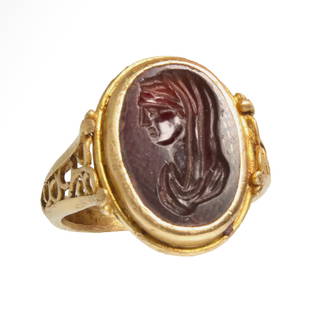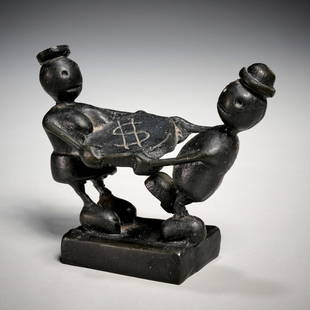
Roman bust of woman, I-II century AD. Marble. Provenance: French collection (G.D.-M.D.).
Similar Sale History
View More Items in Busts
Related Busts
More Items in Busts
View MoreRecommended Sculptures & Carvings
View More








Item Details
Description
Roman bust of a woman, 1st-2nd century AD.
Marble.
Provenance: French collection (G.D.-M.D.).
Measurements: 70 x 58 x 30 cm.
On a simple pedestal stands the bust of a female figure formed by two Roman pieces from different contexts. The head corresponds to the portrait of an empress from the 1st-2nd century AD and the female bust dates from the same period. The piece stands out for the naturalistic representation with which it has been endowed, noticeable both in the capture of her firm expression and in the detailing of her features. His clothing is characteristic, as he wears a tunic that stands out for the drape of its folds.
The Romans brought two important innovations to the world of sculpture: portraiture and historical relief, neither of which existed in the Greek world. However, they followed Greek models for much of their sculptural production, a base which in Rome was combined with the Etruscan tradition. After the first contacts with Classical Greece via the Magna Graecia colonies, the Romans conquered Syracuse in 212 BC, a rich and important Greek colony in Sicily, which was adorned with a large number of Hellenistic works. The city was sacked and its art treasures taken to Rome, where the new style of these works soon replaced the Etruscan-Roman tradition that had prevailed until then. Cato himself denounced the looting and decoration of Rome with Hellenistic works, which he considered a dangerous influence on native culture, and deplored the Romans' applause of statues from Corinth and Athens, while ridiculing the decorative terracotta tradition of ancient Roman temples. However, these oppositional reactions were in vain; Greek art had subdued Etruscan-Roman art in general, to the extent that Greek statues were among the most coveted prizes of war, being displayed during the triumphal procession of the conquering generals. Shortly afterwards, in 133 BC, the Empire.
Marble.
Provenance: French collection (G.D.-M.D.).
Measurements: 70 x 58 x 30 cm.
On a simple pedestal stands the bust of a female figure formed by two Roman pieces from different contexts. The head corresponds to the portrait of an empress from the 1st-2nd century AD and the female bust dates from the same period. The piece stands out for the naturalistic representation with which it has been endowed, noticeable both in the capture of her firm expression and in the detailing of her features. His clothing is characteristic, as he wears a tunic that stands out for the drape of its folds.
The Romans brought two important innovations to the world of sculpture: portraiture and historical relief, neither of which existed in the Greek world. However, they followed Greek models for much of their sculptural production, a base which in Rome was combined with the Etruscan tradition. After the first contacts with Classical Greece via the Magna Graecia colonies, the Romans conquered Syracuse in 212 BC, a rich and important Greek colony in Sicily, which was adorned with a large number of Hellenistic works. The city was sacked and its art treasures taken to Rome, where the new style of these works soon replaced the Etruscan-Roman tradition that had prevailed until then. Cato himself denounced the looting and decoration of Rome with Hellenistic works, which he considered a dangerous influence on native culture, and deplored the Romans' applause of statues from Corinth and Athens, while ridiculing the decorative terracotta tradition of ancient Roman temples. However, these oppositional reactions were in vain; Greek art had subdued Etruscan-Roman art in general, to the extent that Greek statues were among the most coveted prizes of war, being displayed during the triumphal procession of the conquering generals. Shortly afterwards, in 133 BC, the Empire.
Buyer's Premium
- 23%
Roman bust of woman, I-II century AD. Marble. Provenance: French collection (G.D.-M.D.).
Estimate €30,000 - €40,000
1 bidder is watching this item.
Get approved to bid.
Shipping & Pickup Options
Item located in Barcelona, -, esOffers In-House Shipping
Payment

TOP


















































































